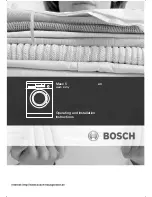
Because Whirlpool Corporation policy includes a continuous commitment to improve
Dimensions are for planning purposes only. For complete details, see Installation
our products, we reserve the right to change materials and specifications without notice.
Instructions packed with product. Specifications subject to change without notice.
ELECTRICAL REQUIREMENTS – Gas models only
VENTING REQUIREMENTS
The dryer must be connected to the cold water faucet using new inlet hoses. Do not use old hoses. Do not overtighten. Damage to the coupling
can result. A cold water faucet should be located within 4 ft. (1.2 m) of the water fill valves, and should have water pressure of 20–100 psi
(137.9–689.6 kPa). You may use the water supply for your washer using the “Y” connector and short hose, which are provided.
Use a 3- or 4-wire, single-phase, 120/240 volt, 60 Hz, AC-only electrical supply (or 3- or 4-wire, 120/208 volt electrical supply, if specified on the serial/
rating plate) on a separate 30 amp circuit, fused on both sides of the line. Connect to an individual branch circuit. Do not have a fuse in the neutral
or grounding circuit. Do not use an extension cord.
GAS SUPPLY REQUIREMENTS
Gas supply:
This dryer is equipped for use with Natural gas. Dryer can be converted to L.P. gas. When rigid pipe is used it should be 1/2" IPS. 3/8"
approved aluminum or copper tubing may be used for lengths under 20 ft (6.1 m) if local codes and gas supplier permit. Lengths over 20 ft (6.1 m)
should use larger tubing and a different size adapter fitting. Pipe-joint compounds resistant to the action of L.P. gas must be used. An individual
manual shut-off valve must be installed within 6 ft (1.8 m) of the dryer in accordance with the National Fuel Gas Code ANSI Z223.1.
WATER (STEAM MODELS ONLY) REQUIREMENTS
INSTALLATION REQUIREMENTS
ELECTRICAL REQUIREMENTS – Electric models only
Use a 3- or 4-wire, single-phase, 120/240 volt, 60 Hz, AC-only electrical supply (or 3- or 4-wire, 120/208 volt electrical supply, if specified on the serial/
rating plate) on a separate 30 amp circuit, fused on both sides of the line. Connect to an individual branch circuit. Do not have a fuse in the neutral
or grounding circuit. Do not use an extension cord.
WARNING:
To reduce the risk of fire, this dryer MUST BE
EXHAUSTED OUTDOORS.
IMPORTANT:
Observe all governing codes and ordinances.
Dryer exhaust must not be connected into any gas vent, chimney, wall,
ceiling, attic, crawlspace, or a concealed space of a building. Only rigid
or flexible metal vent shall be used for exhausting.
■
Only a 4" (102 mm) heavy metal exhaust vent and clamps
may be used.
■
Do not use plastic or metal foil vent.
Rigid metal vent:
■
Recommended for best drying performance and to avoid crushing
and kinking.
Flexible metal vent
(Acceptable only if accessible to clean)
:
■
Must be fully extended and supported in final dryer location.
■
Remove excess to avoid sagging and kinking that may result in
reduced airflow and poor performance.
■
Do not install in enclosed walls, ceilings, or floors.
■
The total length should not exceed 7
3
/
4
ft. (2.4 m).
NOTE:
If using an existing vent system, clean lint from entire length of
the system and make sure exhaust hood is not plugged with lint. Replace
plastic or metal foil vents with rigid metal or flexible metal vents. Review
“Vent System Chart” and, if necessary, modify existing vent system to
achieve best drying performance.
Recommended Styles:
Acceptable Style:
Louvered hood
Box hood
Angled hood
Determine vent path:
■
Select route that will provide straightest and most direct path
outdoors.
■
Plan installation to use fewest number of elbows and turns.
■
When using elbows or making turns, allow as much room
as possible.
■
Bend vent gradually to avoid kinking.
■
Use as few 90° turns as possible.
Determine vent length and elbows needed for best drying
performance:
■
Use following “Vent System Chart” to determine type of vent material
and hood combinations acceptable to use.
NOTE:
Do not use vent runs longer than those specified in “Vent
System Chart.” Exhaust systems longer than those specified will:
■
Shorten life of dryer.
■
Reduce performance, resulting in longer drying times and
increased energy usage.
The “Vent System Chart” provides venting requirements that will help
achieve best drying performance.
Number of
90° turns
or elbows
Type
of vent
Box/louvered
hoods
Angled
hoods
0
Rigid metal
64 ft. (20 m)
58 ft. (17.7 m)
1
Rigid metal
54 ft. (16.5 m) 48 ft. (14.6 m)
2
Rigid metal
44 ft. (13.4 m) 38 ft. (11.6 m)
3
Rigid metal
35 ft. (10.7 m)
29 ft. (8.8 m)
4
Rigid metal
27 ft. (8.2 m)
21 ft. (6.4 m)
Vent System Chart
4"
(102 mm)
4" (102 mm) heavy metal exhaust vent
Exhaust hoods:
■
Must be at least 12" (305 mm) from ground or any object that may
obstruct exhaust (such as flowers, rocks, bushes, or snow).




















